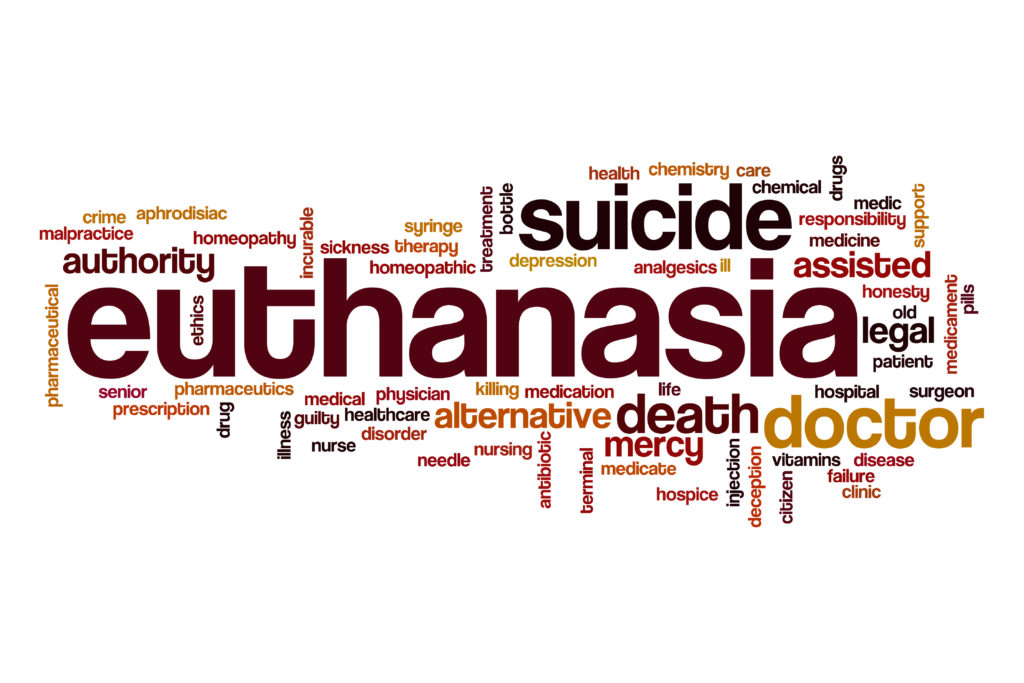A month after California’s assisted suicide law went into effect this summer, one of its biggest advocates sent an email update about the success of its awareness campaign. The email from Matt Whitaker, California State Director of Compassion & Choices, reads:
Since we launched the California Access Campaign, we’ve been at work providing public education, compiling resources and building tools that will make access to the best end-of-life care possible … Take a look at what we’ve accomplished so far:
– Given over 380 community presentations
– Conducted 38 workshops for medical providers
Start your day with Public Discourse
Sign up and get our daily essays sent straight to your inbox.– Deployed 23 local Action Teams
– Contacted over 200 hospices
– Trained over 1,437 volunteers
– Produced a series of videos for healthcare providers.
The well-orchestrated outreach effort also includes “impressive digital products” such as a brand-new website, and a “one-of-a-kind Find Care Tool that you can use to see the range of end-of-life services at medical centers near you simply by entering your zip code.”
While it’s deplorable that so much talent, time, and treasure is being spent in the service of helping doctors kill their patients, the speed and scope of Compassion & Choices’ community organization is noteworthy. Here are two lessons opponents should learn from their rapid and comprehensive approach.
Grassroots Pressure Works
Consider the recent about-face from Huntington Hospital. With over 800 affiliated physicians providing care to the greater San Gabriel Valley area, the Pasadena-based hospital initially approved an amendment to its internal rules opting out of the new assisted suicide regime. According to media reports, the new language stated:
Huntington Hospital has chosen not to participate in the act, and therefore no Huntington Hospital employees, independent contractors, or other persons or entities that work at or with Huntington Hospital may participate in activities under the act while on the premises of Huntington Hospital, or while acting within the scope of any employment or contractual relationship with Huntington Hospital.
Religiously affiliated hospitals are expected to make up most of those opting out, so secular Huntington Hospital’s blanket refusal to participate was somewhat surprising. Without the protection of a religious liberty claim, Huntington’s position basically amounted to an ethical stance that killing a patient is not proper medical care. That’s a threat to C&C’s argument that only blindly dogmatic caregivers oppose assisted suicide. So even though California’s assisted suicide law accommodates Huntington’s initial decision—and despite the fact that larger providers such as UCLA, Sutter Health, and Kaiser Permanente already support the law—assisted suicide advocates could not risk the embarrassment of such a high-profile, secular holdout. Huntington needed to be brought to heel before others followed their lead.
Fast forward to August. C&C’s Whitaker is now emailing to share the good news that Huntington Hospital is not only allowing its doctors to participate in assisted suicides, it “took the unprecedented step of purchasing a full page ad in the LA Times to celebrate the move!” Lest readers mistake who is responsible for the shift, Whitaker elaborates. “It’s important to understand that Huntington did not come to this decision on their own. It was outspoken supporters of [assisted suicide] that made their disappointment in Huntington’s initial decision known. They called, emailed and submitted op-eds on the subject—and their pressure worked!”
And there’s more to come. Whitaker ends his update with a promise: “There will be more opportunities in the near future to do the same with medical centers near you that are limiting patient options by not allowing doctors to participate” in assisted suicide. Euphoric over its turnaround in Pasadena, C&C wants to replicate its success in silencing opposition everywhere it exists.
Opponents of assisted suicide can fight back—and they can use C&C’s own “Find Care Tool” to help them. Residents of California can plug in their ZIP code and select a search radius. Whichever hospitals appear in favor of the law should become the focus of a grassroots campaign to pressure the hospital into changing its position. Thanks to C&C, we know what works: a barrage of phone calls, emails, and op-eds in local newspapers. Throw in an on-site demonstration or two and an awareness campaign emphasizing the hospital’s embrace of killing-as-treatment and the placards almost write themselves.
Work through Professionals to Reach Clients
C&C is making inroads with frontline professionals. Look again at the C&C action item list above. Workshops and videos for medical and health-care providers. Over 200 hospices contacted. More than 1,400 volunteers trained. Unstated in this frenzy of activity is the reality that C&C is successfully infiltrating the workspaces of California’s end-of-life service providers. In so doing, it is changing how people think about life and death in ways that make assisting in a suicide seem like morally upright behavior.
Consider C&C’s “Doc2Doc” program. It offers a twenty-four-hour hotline for physicians wanting to navigate an assisted suicide law. It provides links to compliance forms and an unlimited number of free consultations. It disseminates talking points and even tutorials on other types of “patient-controlled death,” such as VSED, or Voluntarily Stop Eating and Drinking. Most people would call this starving to death.
Then there is the “Good to Go” toolkit for advanced health-care directives. It is an ideal resource for estate-planning attorneys desiring prearranged checklists and templates. A Values Worksheet lists several common questions about quality-of-life and treatment options, rated along a spectrum. The toolkit has several documents that can be attached to an advanced directive, such as a Dementia Provision, a Transfer Order from a non-assisted-suicide hospital, and a Hospital Visitation Form that gives preference to non-family members (presumably in favor of people who support C&C’s agenda).
It’s time for the opposition movement to launch an educational counterstrike.
An obvious place to start is with doctors. Conversations about assisted suicide can now emerge at any time. Since January, Medicare is reimbursing physicians for up to two thirty-minute end-of-life consultations. In states like California where assisted suicide is legal, doctors must be ready to respond. Answers like, “I don’t participate,” or “I think it’s wrong,” don’t help the patient. We need doctors who are skilled in clinical and conversational techniques that identify what’s motivating the request to die.
One approach would be to train physicians how to spot symptoms of depression, since this is commonly linked with suicidal thoughts. Psychiatric evaluations are not required by US assisted suicide laws, unless the physician receiving the initial request thinks it necessary. Evidence from Oregon and Washington suggests this lax standard virtually ensures almost no evaluations will be done because most doctors are not familiar with mental health protocols. Instead, if a patient meets the criteria and says she wants to die, the pathway for assisted suicide is opened.
Another key target audience should be estate-planning attorneys. A common experience for clients making an estate plan is to receive a detailed consultation from an attorney about financial end-of-life options—wills, trusts, charitable donations, etc.—but only a cursory session about health-care decisions. In many cases, people resort to a checklist that, like the one provided by C&C, focuses on the treatment they don’t want. Few attorneys have the interest or formation necessary to balance the conversation with counter-examples. For instance, many people might think they would refuse a ventilator or a feeding tube. But what if one of those devices made it possible to live an otherwise normal life? Would the same person refuse a pacemaker or confinement to a wheelchair on the same grounds?
All of this outreach can and should be done in ways that meet the needs of frontline end-of-life professionals. Continuing education credits should be developed to make it easier for busy specialists to receive training. Partnerships with local associations could make seminars and materials more readily available within their networks. Communication with these groups could provide a continuous dialogue that improves the training process by incorporating best practices from different regions and cultures.
Assisted suicide is not yet an entrenched reality in California. Pushing back hard against the tide of C&C’s activism can create enough space for an alternative approach to end-of-life counseling to take hold and grow. The fight over assisted suicide is far from over, so it is critically important that every possible effort is made to establish a parallel structure in law and medicine as quickly and robustly as possible.
Fighting Ideas, Not People
Having attended a C&C information session in Los Angeles in 2015, I can say that its outreach efforts are just as deceptively appealing in person as they are online. The tone of the presentation is empathetic, and the resources C&C provides are designed to eliminate fears of unwanted suffering. Immersing oneself in the material, one is tempted to forget that the only services C&C really provides is making suicide more efficient.
It is important to remember that the vast majority of people being swept up into this movement are not pro-death ideologues. They are people who genuinely want to do what’s right for those they love. Many have seen family and friends die painful deaths. They want to help others avoid a similar fate. The problem is that they are being bombarded with false messages of compassion. There is nothing kind about killing your patient. There is nothing heroic about handing poison to a loved one.
Though C&C’s email updates exude the air of a confident community organizer, it would be a mistake to assume its ultimate success. Because legalized assisted suicide is such an extreme case of social engineering—in which mental health safeguards like mandatory psychiatric evaluations are ignored—advocates for the law must engage in an intellectual blitzkrieg to overwhelm the opposition. Only by convincing opponents that the game is lost can supporters impose their radical vision of self-destructive autonomy on an unsuspecting populace.
Opponents of assisted suicide know better. Hospitals need to hear from powerful voices in their community that participation in the killing of patients is unacceptable. Professionals who don’t buy into C&C’s narrative need training to combat it.
A playbook exists for reversing the slide toward death-on-demand. It’s time to use C&C’s tactics against it.














